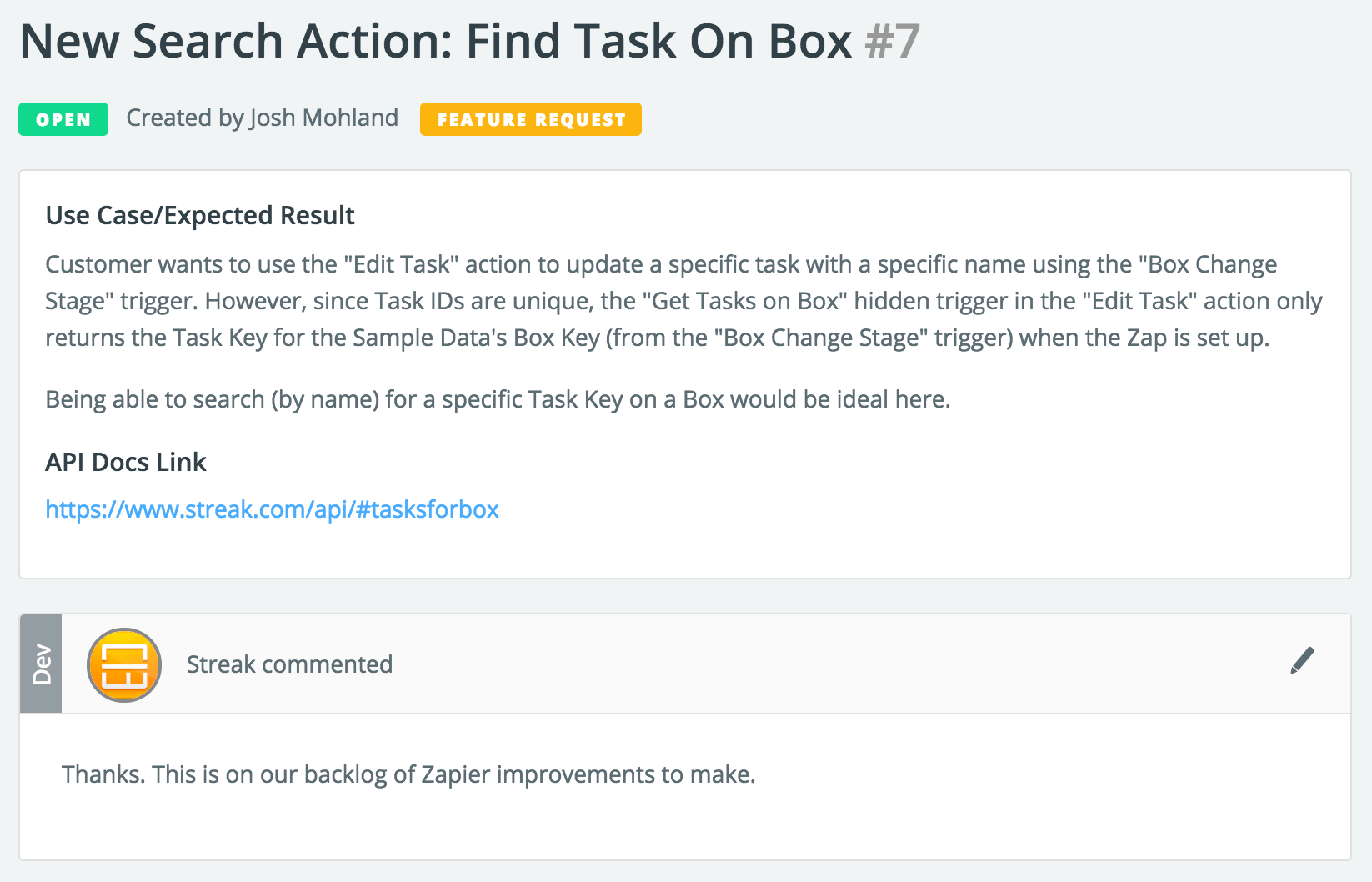Introducing Zapier Issues: Your Product Development Partner

Inspiration springs from customers who use your product to its fullest. These power-users thrive on Zapier, where they can define precise workflows and bring your app along. They have a knack for finding bugs and pushing the boundaries of what’s possible—resulting in feature requests and a better experience for all your users.
We see thousands of app combinations and complex workflows from more than 1.5 million people—and we want to give you more insight into how your best customers use your app on Zapier.
Starting today, any public app connected to Zapier can see filtered, categorized feedback from their users with Zapier Issues, then use that information to improve the integration.

Zapier Issues helps your team collect and act on feature requests for your Zapier integration, so you can build a better experience for your best customers.
Successful companies make improvement a habit. Zapier Issues gives you another way to listen to your most valuable users. Rather than figuring out what to build on your own, we can tell you what we’ve learned from our mutual customers.
For example, the team at Acuity Scheduling got a preview of Zapier Issues. They learned their users wanted to build Zaps (automated app workflows) around specific types of appointments, such as internal and external meetings. They wanted to create smarter automations that distinguished between those types of appointments. Based on that feature request from Zapier users, Acuity Scheduling updated its app and we notified Zapier users who requested this feature that it was available.
“Zapier Issues has been great. Right away it gave us a complete picture of some things missing from our integration, and we were able to make a few updates pretty much immediately.” — Carl Sutherland, Acuity Scheduling
As a way to understand our customers and provide what’s best for them, we’ve been collecting bugs and features requests for Zapier integrations as they roll in. Now we’re sharing this data with any public app on Zapier so you can eliminate bugs and discover new use cases to improve the integrations your customers rely upon.
With results like those we’ve seen during our early access period, we think it could be really useful for you, whether your app is on Zapier already or you’re planning to build on our developer platform.
Find out more about feature requests and bugs from Zapier Issues below, or learn how it works in our documentation.
Feature Requests Help You Discover New Use Cases
Product feedback points you towards the improvements that matter. Whether you’re an engineer, product manager, or another member of the team, feedback gives you the confidence that you’re moving in the right direction. It’s a huge part of our process at Zapier too.
But not all feature requests from customers come through as actionable roadmap entries. It can be painful to add yet another long tail request that you know you’ll never implement. Zapier Issues helps by providing feedback around use cases—with built-in prioritization and an implementation path that won’t clutter your primary product.
“Zapier Issues provides invaluable data for our product team” — Lauren Hunter, Senior Technical Customer Advocate, Typeform
Feature requests come from conversations with Zapier’s fabulous support team. Your customers have something they want to accomplish, integrating two or more apps into their workflow. Requests always surround a use case, a problem they’re actively trying to solve. When something is not possible or requires complicated workarounds, they’ll let us know about it. Our team converts the customer’s request into the Zapier terms of triggers, actions, and searches. This atomic approach means one feature request can be useful across multiple use cases.
Many times we’ll hear the same feedback from multiple users. Requests in Zapier Issues include the number of customers who are waiting to hear back about a resolution. While we think even a single person is representative of many others who didn’t write in, you can use this count as a rough prioritization when considering which features to implement in your Zapier app.

Of course, the best part about updating your Zapier integration is that you’re adding functionality to your app without cluttering up its interface. Also, since these updates are more granular than your typical new feature, you’re making your app even more powerful, providing building blocks that your customers can fit precisely into their workflows.
Ok, actually, the best part of improving your Zapier app might be that we’ll gladly help spread the word. All new features are announced on our Updates Blog and sent out to our list of over 850,000 email subscribers—each one an app lover.
That's Not a Feature, That's a Bug
Feature requests are exciting, but bugs reports can be scary. They mean a customer is having a bad experience that often requires engineering effort to fix.
But know what's scarier than a reported bug? An unreported one.
Bugs are added to Zapier Issues the same way as feature requests. They all start out as conversations with our support team. The customer may have received an error in their Zap or may be having trouble getting the data they expect. Either way, they’ve reached out to say “this doesn’t seem right.” Our team investigates, looking through request logs and response data. When we’ve eliminated other explanations for the issue, we file a bug with as much background information as we can include.
“Zapier Issues really opens up a great collaborative space to work with Zapier's team to solve customer issues” — Sean Matthews, Left Hook Digital
Zapier sends and receives millions of API calls per day, and we have customers doing advanced things with data from your app. This means we’re often the first to discover problems, even when you have great internal systems to catch them.
The varied use cases and scale of requests mean we provide a unique test suite for your API. Heck, we even have a public status.zapier.com site where you can check if a popular web app is down or not.
There's a bright side to bugs: they help you understand how customers use your app and give you the opportunity to improve their experience. Better yet, if we noticed an issue with your API, you can fix it for other developers, too. Integrations are part of how your customers experience your app, so you want to ensure they work as well as your other software. The only way to give bugs that level of support is to have robust tools to track and fix them. That’s how we see Zapier Issues playing an important role for many partners who have already tried it and for those who will check out Zapier Issues now that it's available.
Connect Your Product and Ecosystem
You already give a lot of attention to your product. It’s what your customers see and interact with every day. The ecosystem around your app is also important. For many companies, this fertile ground gets far less attention. Zapier Issues is an opportunity to thread together these two elements of your customer experience.
There have long been some major benefits to building on the Zapier Platform. With Issues now visible in any public app, we’ve added elevating your ecosystem to the list. You’ll receive more insight than ever before into how your app is performing on Zapier. And you’ll have access to rich, filtered feedback from our mutual customers.
If your app is already available on Zapier, be sure to check out the Issues tab in your app settings. Otherwise, get started now developing your app with Zapier.
Comments powered by Disqus